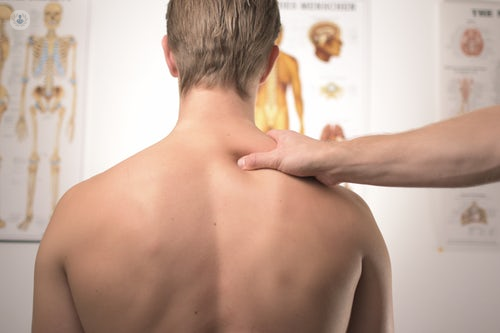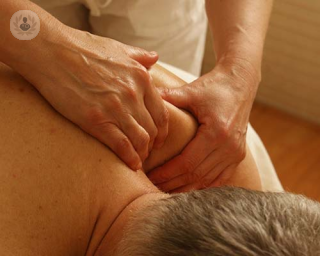Spondylosis
Dr Francis Kynaston-Pearson - Rheumatology
Created on: 11-06-2017
Updated on: 06-28-2023
Edited by: Conor Dunworth
What is spondylosis?
The term “osis” refers to a disease process whilst “spond” refers to the spine. Spondylitis, therefore, is “itis” of the spine which refers to inflammation. Whilst some of the symptoms are shared in common, the underlying cause and treatment for this can vary considerably.
Spinal degeneration is what is being referred to with spondylosis and is very common with increasing age and a rather broad term that is more of a description than a specific diagnosis. The amount of change seen on imaging of the spine does not always correlate well with physical symptoms which can also confuse matters. The most common condition referred to as spondylosis is osteoarthritis of the spine.

What are the symptoms of spondylosis?
Osteoarthritis is usually referred to as “wear and tear” which is only half of the story. The other half is the process of improper repair which can see extra bone growth arise as the body tries to compensate for the loss of normal joint tissue with age and use. Because of this extra bone, spondylosis can cause radiculopathy (a pinched nerve), which can produce symptoms like pain (often described as shooting, tingling or burning and sometimes severe). This can start in the back, neck, or shoulder but run down into a limb like the arm or leg.
Some patients may also have problems with their spinal discs which can compress nerves that exist in the spine or in severe cases may even compress the spinal cord itself. Symptoms such as weakness, a reduced sensation in the genital area or incontinence are emergency features of spinal disc disease that should be dealt with immediately in hospital.
It can occur in any part of the spine (cervical, thoracic, lumbar or lumbosacral) and is one of the most common causes of musculoskeletal complaints.
The condition is not classified as an inflammatory disease however, and while a rheumatologist may help in making a diagnosis, they are unlikely to be involved in the long-term care of this condition.
Treatments include rest initially, exercise (especially core strength with Yoga and Pilates), weight management and other supportive services like osteopathy, a chiropractor or massage therapy. In more severe cases, a more comprehensive pain management programme is required.
How is spondylosis different to spondylitis?
The spondylarthritis conditions are often referred to collectively as the “seronegative spondyloarthritidies”. In basic terms, this means inflammatory conditions that have no known positive antibody test (like rheumatoid arthritis does) that cause inflammation in the spine. They comprise four main conditions, psoriatic, ankylosing, enteropathic and reactive spondyloarthritis. The hallmark of these conditions is inflammation that affects the tendon at the point it joins the bone – the so-called “enthesis”.
The central condition is Ankylosing Spondylitis. This condition comes at any time from late childhood onwards and usually cannot be diagnosed if symptoms started after the age of 50. The lower joints of the spine are commonly involved giving rise to pain that moves into the buttocks. Symptoms are usually worse first thing in the morning (and associated with stiffness) and are made better with anti-inflammatories and exercise. There is a genetic link (with one gene in particular being associated called HLA-B27) however the exact cause is still being investigated.
What is the treatment for spondylitis?
Back pain from mechanical causes (like spondylosis) is far more common than inflammatory diseases. Because of this, there sadly still a long delay in getting a diagnosis for patients with spondylitis. It is crucial therefore to be seen by a specialist if you have features that best fit an inflammatory cause so that your symptoms can be properly investigated and treatment, if appropriate, commenced.
As an initial intervention, most patients will be offered non-steroidal anti-inflammatory medication (NSAIDs) like ibuprofen or naproxen. While these are common painkillers, you may need to use these regularly every day to get the best effects. Because of this, patients commonly need protection for their stomach with treatments like omeprazole.
Because this is a long-term disease, it is vitally important to learn more about your condition and how best to manage it. A specialist programme with a physiotherapist involving education and exercise is usually part of the treatment.
For individuals with more persistent disease, newer targeted agents such as biological therapies can be prescribed. This includes medication like anti-TNF drugs, IL-17 drugs and JAK inhibitors.


